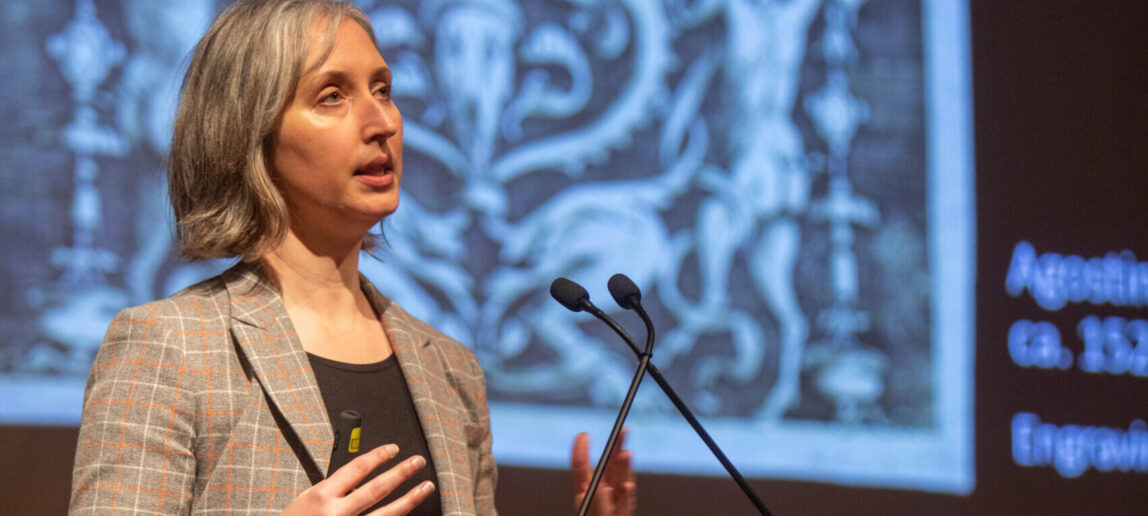Uchacz Honored With Montague-CTE Scholars Award For Development Of Teaching Excellence
Dr. Tianna Uchacz, assistant professor of art history and craft technology in the Visualization program in the Texas A&M College of Performance, Visualization and Fine Arts, was recently honored with the Montague-CTE Scholars Award, presented by the Texas A&M Center for Teaching Excellence.
The award, now in its 33rd year, is given to tenure-track assistant professors based on their early success and passion for teaching undergraduate students. The $6,500 grant goes to further development of their teaching excellence.
Uchacz’s research involves art media and materials, skilled making, the sensory experiences of artists and viewers, and ways of knowing in cultures across the globe. She received her Ph.D. from the University of Toronto in 2016 and was a postdoctoral scholar at Columbia University from 2016 to 2020.
“It is a huge honor to be recognized for the thought and the care that I put into teaching,” Uchacz said. “Tenure-track professors often hear that teaching is as important as research, but our duties are often heavily oriented toward research. It’s nice to have an institutional award that recognizes and validates the importance of teaching.”
With the grant, Uchacz plans to expand her capacity to teach a hands-on history activity: making pigments and paint from plants and insects according to Renaissance recipes. She previously taught this activity to students in her honors section and graduate seminars. The goal is to give a full section of 200 students in her Art History Survey ll class an “aha!” moment of nature and science coming together to facilitate art, she said.
To make this happen, Uchacz said she will need to purchase additional equipment including hot plates, glassware, beaker tongs, mortars and pestles, along with consumables including dried cochineal insects, madder root, filter paper and plastic containers.
“I want the students to keep in mind that Renaissance artists didn’t have a Michael’s art supply store or a Hobby Lobby where they could simply buy every supply they needed,” she said. “My studies and research revolve around the investigation of an era when artists were proto-scientists. They were investigating the natural world and transforming the things that they found to suit their needs, which is what my students will learn how to do.”
Having the ability to make the tools for producing the art will remind students that art is not “simply something that hangs on a wall or sits on a pedestal,” but rather results from skill in material transformation, she said. The plan is to demystify the work of art by contextualizing it as materials and making processes, Uchacz said.
“I have my students make the ‘stuff’ of art and understand the issues around handling, gesture, dexterity, mind-body coordination, embodied cognition — all of these things we take for granted when we see a finished piece,” she said. “I want students to consider what it actually took to make a work of art. That allows them to approach art history in a different way.”
During the hands-on activity, students will develop an appreciation of the material qualities of historical works of art, which Uchacz believes is an undervalued skill in the art world. They can then better imagine how a piece of wood or a lump of clay could be used in making art, she said.
Students will create pigments with dried cochineal insects in Uchacz’s project. After crushing and soaking the insects, a fuchsia-colored dye emerges, she said. Following that, students will produce pigments by precipitating the dye onto a substrate. Once they mix the pigment into a binder such as linseed oil or egg yolk, it becomes a paint that they can use in their art, Uchacz said.
“I am a firm believer in hands-on learning because it allows students to connect with art,” she said. “When we start to get our hands dirty, we learn that art is as much about skill as it is about concept.”
By creating a space for students to a have hands-on learning experience, they can disengage from their screens and be present in the moment, Uchacz said.
“I want them to experience and be really mindful about the world around them,” she said. “I hope to give them a push to engage experimentally with the materials they find in the real world, just like a Renaissance artist, and I want them to be open to failure. I want them to recognize the value of process over product and learn from that shift in focus. I want them to get messy and be open to the messiness of art and life.”
Photo by Glen Vigus, operations director for the Texas A&M College of Performance, Visualization and Fine Arts.

